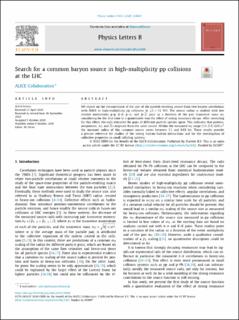Search for a common baryon source in high-multiplicity pp collisions at the LHC
Acharya, Shreyasi; Adamová, Dagmar; Adler, Alexander; Adolfsson, Jonatan; Aggarwal, Madan M.; Aglieri Rinella, Gianluca; Agnello, Michelangelo; Agrawal, Nikita; Ahammed, Zubayer; Ahmad, Shafiq F.; Alme, Johan; Altenkaemper, Lucas; Djuvsland, Øystein; Eikeland, Viljar Nilsen; Ersdal, Magnus Rentsch; Fionda, Fiorella Maria Celeste; Grøttvik, Ola Slettevoll; Lofnes, Ingrid Mckibben; Nystrand, Joakim; Rehman, Attiq Ur; Røhrich, Dieter; Tambave, Ganesh Jagannath; Ullaland, Kjetil; Wagner, Boris; Yang, Shiming; Yuan, Shiming; Zhou, Zhuo; Arsene, Ionut Cristian; Dordic, Olja; Lardeux, Antoine Xavier; Mahmood, Sohail Musa; Malik, Qasim Waheed; Neagu, Alexandra; Richter, Matthias; Røed, Ketil; Skaali, Toralf Bernhard; Tveter, Trine Spedstad; Wikne, Jon Christopher; Helstrup, Håvard; Hetland, Kristin Fanebust; Kileng, Bjarte; Nesbø, Simon Voigt; Storetvedt, Maksim Melnik; Langøy, Rune; Lien, Jørgen André; Ahn, Sang Un; Akbar, Zaenai; Akindinov, Alexander; Al-Turany, Mohammed; Alam, Sk Noor; ALICE, Collaboration
Journal article, Peer reviewed
Published version

Åpne
Permanent lenke
https://hdl.handle.net/11250/2733833Utgivelsesdato
2020Metadata
Vis full innførselSamlinger
Sammendrag
We report on the measurement of the size of the particle-emitting source from two-baryon correlations with ALICE in high-multiplicity pp collisions at √s = 13 TeV. The source radius is studied with low relative momentum p–p, p^- –p^-, p–Λ , and p^-–Λ^- pairs as a function of the pair transverse mass m_T considering for the first time in a quantitative way the effect of strong resonance decays. After correcting for this effect, the radii extracted for pairs of different particle species agree. This indicates that protons, antiprotons, Λ s, and Λ^- s originate from the same source. Within the measured m_T range (1.1–2.2) GeV/c^2 the invariant radius of this common source varies between 1.3 and 0.85 fm. These results provide a precise reference for studies of the strong hadron–hadron interactions and for the investigation of collective properties in small colliding systems.
